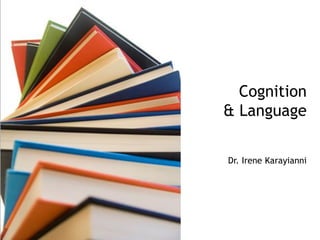
Cognition and language
- 1. Cognition & Language Dr. Irene Karayianni
- 2. Cognitive Psychology thinking language memory Problem solving knowing reasoning judging Decision making
- 5. Concepts: Categorizing the World
- 6. Syllogistic reasoning • Premise 1 All professors are mortal. • Premise 2 Dr. Rivera is a professor. • Conclusion Therefore, Dr. Rivera is mortal. • Premise 1 All professors are mortal. • Premise 2 Professor Rivera is a professor. • Conclusion Therefore, all professors are Dr. Rivera.
- 7. Algorithms and heuristics algorithm heuristic representativeness heuristic availability heuristic
- 10. Steps of problem solving
- 11. Step 1 Preparation: Understanding and Diagnosing New problem Familiar problem Well defined problem Ill defined problem or or Pay attention to restrictions Spend less time in preparation straightforward judgments Unclear nature of problem Info required to solve it is not obvious
- 12. Step 1 Preparation: Understanding and Diagnosing Kinds of problems: arrangement problems
- 13. Step 1 Preparation: Understanding and Diagnosing Kinds of problems: inducing structure
- 14. Step 1 Preparation: Understanding and Diagnosing Kinds of problems: transformational
- 16. Step 1 Preparation: Understanding and Diagnosing Representing and organizing the problem
- 17. Step 2 Production: generate solutions direct solution stored in LTM Trial and error
- 18. Step 2 Production: generate solutions heuristics Means-end analysis Work backwards – focus on goal Forming sub-goals Divide problems into their parts
- 19. Step 2 Production: generate solutions Insight: sudden awareness
- 20. Step 3 Judgment: evaluating solutions
- 21. Barriers to Solutions: Why Is Problem Solving Such a Problem? Functional fixedness
- 22. Barriers to Solutions: Why Is Problem Solving Such a Problem? Inaccurate evaluation of solutions Confirmation bias
- 23. Creativity and Problem Solving
- 24. Increasing critical thinking & creativity • Redefine problems. We can modify boundaries and assumptions by rephrasing a problem at either a more abstract or a more concrete level. • Use subgoals. By developing subgoals, we can divide a problem into intermediate steps. This process, known as fractionation, allows us to examine each part for new possibilities and approaches, leading to a novel solution for the problem as a whole. • Adopt a critical perspective . Rather than passively accepting assumptions or arguments, we can evaluate material critically, consider its implications, and think about possible exceptions and contradictions. • Consider the opposite. By considering the opposite of a concept we’re seeking to understand, we can sometimes make progress. For example, to define “good mental health,” it may be useful to consider what “bad mental health” means. • Use analogies . Analogies provide alternative frameworks for the interpretation of facts and help us uncover new understanding. • Think divergently . Instead of the most logical or common use for an object, consider how you might use the object if you were forbidden to use it in the usual way. • Use heuristics . Heuristics are cognitive shortcuts that can help bring about a solution to a problem. If the problem has a single correct answer and you can use or construct a heuristic, you can often find the solution more rapidly and effectively. • Experiment with various solutions . Don’t be afraid to use different routes to find solutions for problems (verbal, mathematical, graphic, even dramatic). For instance, try to come up with every conceivable idea you can, no matter how wild or bizarre it may seem at first. After you’ve come up with a list of solutions, review each one and try to think of ways to make what at first appeared impractical seem more feasible.
- 25. Language
- 26. Grammar: Language’s language phonology, syntax, semantics Phonemes: fat, fate “John kidnapped the boy” “John, the kidnapped boy” “The boy kidnapped John
- 28. Developing language: production of language Telegraphic speech Overgeneralization
- 29. Developing language: language acquisition Learning Theory Approaches: Language as a Learned Skill language acquisition follows the principles of reinforcement and conditioning Nativist Approaches: Language as an Innate Skill humans are born with an innate linguistic capability that emerges primarily as a function of maturation. All the world’s languages share a common underlying structure called a universal grammar Interactionist Approaches: combination of the above we have the hardware that allows us to develop language, and exposure to language in our environment allows us to develop the software to understand and produce language
- 30. The influence of language on thinking linguistic-relativity hypothesis: language is the cause of certain ways of thinking; language shapes and may determine the way people in a specific culture perceive and understand the world. Vs. thought produces language
- 31. Do animals use language? Kanzi: https://www.youtube.com/watch?v=jKauXrp9dl4
